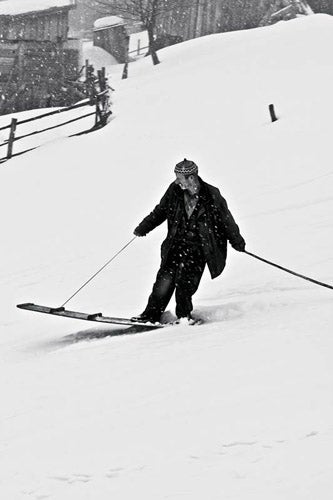Snowboarding Is Older Than You Think

People were pursuing animals and enemies on skis before the invention of the wheel. Because two-legged snow travel persisted for thousands of years, no one thought of sliding downhill on anything other than two skinny boards when skiing became a recreational sport. Then, epiphany! Suddenly, about 30 years ago, the Burton snowboard appeared. Here, it seemed, was a radical new way to slide downhill.
Not so fast. In fact, one-plank snow surfing had been around since long before Burton’s board exploded onto the scene. In the mid-1970s, actor and director Robert Redford surfed deep powder on a P-Tex-bottomed, metal-edged board called the Winter Stick. In the 1960s, pioneering boarder Tom Sims fashioned a “skiboard” aimed at mimicking skateboarding on snow.
Historian Paul J. MacArthur describes a 1968 Slalom Snow Ski designed like a waterski, with your front foot facing forward and rear foot at a 45-degree angle. (Another board was made with magnets to keep boots in place.)
In 1966, the Brunswick Corporation began selling—through toy and department stores—tens of thousands of Snurfers, a children’s length ski board. For
stability, you held onto a rope attached to the tip. (As a boy, Jake Burton Carpenter enjoyed riding his Snurfer so much that he no longer wanted to ski—and was inspired to one day design something better.)
In the 1930s, kids experimented with standing up on their toboggans, holding onto the towrope for balance. In 1939, Midwesterner Vern Wicklund patented a sophisticated toboggan with a foot strap and rubber pads to stand on. His idea seemed novel until recently, when a couple of American snowboarders in the snow-rich Turkish mountains near the Black Sea discovered people riding sideways standing on sleds, steering them with rudder-like sticks.
Turks think their lazboard has been around for 400 years, having been invented around 1600. Big-mountain snowboard pioneer and manufacturer Jeremy Jones brought one back with him from Turkey and has been successfully riding it in Alaska.
None of these early toboggan-like devices produces the modern snowboard’s exotic sensation of banking against the centrifugal force of the turn, feet extended laterally, with nothing between your upper body and the snow. That happened in the 1980s. Shaped skis and terrain parks followed. And the sport was transformed. But one thing’s for sure, it wasn’t born yesterday.